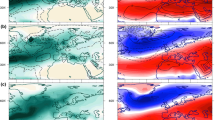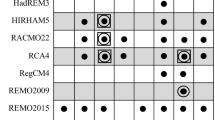Abstract
Two ensemble simulations with the ECHAM5/MPI-OM climate model have been investigated for the atmospheric response to a thermohaline circulation (THC) collapse. The model forcing was specified from observations between 1950 and 2000 and it followed a rising greenhouse gases emission scenario from 2001 to 2100. In one ensemble, a THC collapse was induced by adding freshwater in the northern North Atlantic, from 2001 onwards. After about 20 years, an almost stationary response pattern develops, that is, after the THC collapse, global mean temperature rises equally fast in both ensembles with the hosing ensemble displaying a constant offset. The atmospheric response to the freshwater hosing features a strong zonal gradient in the anomalous 2-m air temperature over Western Europe, associated with a strong land–sea contrast. Since Western Europe climate features a strong marine impact due to the prevailing westerlies, the question arises how such a strong land–sea contrast can be maintained. We show that a strong secondary cloud response is set up with increased cloud cover over sea and decreased cloud cover over land. Also, the marine impact on Western European climate decreases, which results from a reduced transport of moist static energy from sea to land. As a result, the change in lapse rate over the cold sea surface temperature (SST) anomalies west of the continent is much larger than over land, dominated by changes in moisture content rather than temperature.











Similar content being viewed by others
References
Bryden HL, Longworth HR, Cunningham SA (2005) Slowing of the Atlantic meridional overturning circulation at 25°N. Nature 438(7068):655–657. doi:10.1038/nature04385
Chang P, Zhang R, Hazeleger W, Wen C, Wan X, Ji L, Haarsma RJ, Breugem W–P, Seidel H (2008) Oceanic link between abrupt changes in the North Atlantic Ocean and the African monsoon. Nature Geoscience. doi:10.1038/ngeo218
Cheng W, Bitz CM, Chiang JCH (2007) Adjustment of the Global Climate to an Abrupt Slowdown of the Atlantic Meridional Overturning Circulation. Geophys Monogr 1973:295–314
Cunningham SA, Kanzow T, Rayner D, Baringer MO, Johns WE, Marotzke J, Longworth HR, Grant EM, Hirshi JJ, Beal LM, Meinen CS, Bryden HL (2007) Temporal variability of the Atlantic meridional overturning circulation at 26.5°N. Science 317(5840):935–938. doi:10.1126/science.1141304
Dong B-W, Sutton RT (2002) Adjustment of the coupled ocean-atmosphere system to a sudden change in the Thermohaline Circulation. Geophys Res Lett. doi:10.1029/2002GL015229
Harrison EF, Minnis P, Barkstrom BR, Ramanathan V, Cess RD, Gibson GG (1990) Seasonal variation of cloud radiative forcing derived from the earth radiation budget experiment. J Geophys Res 95:18687–18703. doi:10.1029/JD095iD11p18687
Joshi MM, Gregory JM, Webb MJ, Sexton DMH, Johns TC (2008) Mechanisms for the land-sea warming contrast exhibited by simulations of climate change. Clim Dyn. doi:10.1007/s00382-007-0306-1
Manabe S, Stouffer RJ (1988) Two stable equilibria of a coupled ocean–atmosphere model. J Clim 1:841–866. doi:10.1175/1520-0442(1988)001<;0841:TSEOAC>;2.0.CO;2
Manabe S, Stouffer RJ (1999) The role of thermohaline circulation in climate. Tellus 51 A-B:91–109
Marsland SJ, Haak H, Jungclaus JH, Latif M, Röske F (2003) The Max-Planck-Institute global ocean/sea ice model with orthogonal curvilinear coordinates. Ocean Model 5:91–127. doi:10.1016/S1463-5003(02)00015-X
Nakicenovic N, et al. (2000) Special Report on Emissions Scenarios: A special report of working group III of the Intergouvernmental panel on climate change. Cambridge University Press, Cambridge, UK. Available online at www.grida.no/climate/ipcc/emission/index.htm
Roeckner E, Bäuml G, Bonaventura L, Brokopf R, Esch M, Giorgetta M, Hagemann S, Kirchner I, Kornblueh L, Manzini E, Rhodin A, Schlese U, Schulzweida U, Tompkins A (2003) The atmospheric general circulation model ECHAM 5. Part I: model description. Tech. Rep. 349. Max-Planck-Institut für Meteorologie, Hamburg
Schmittner A, Latif M, Schneider B (2005) Model projections of the North Atlantic thermohaline circulation for the 21st century assessed by observations. Geophys Res Lett. doi:10.1029/2005GL024368
Sterl A, Severijns C, Dijkstra H, Hazeleger W, van Oldenborgh GJ, van den Broeke M, Burgers G, van den Hurk B, van Leeuwen PJ, van Velthoven P (2008) When can we expect extremely high surface temperature? Geophys Res Lett. doi:10.1029/2008GL034071
Stone PH, Carlson JH (1979) Atmospheric lapse rate regimes and their parameterization. J Atmos Sci 36(3):415–423
Stouffer RJ, Yin J, Gregory JM, Dixon KW, Spelman MJ, Hurlin W, Weaver AJ, Eby M, Flato GM, Hasumi H, Hu A, Jungclaus JH, Kamenkovich IV, Levermann A, Montoya M, Murakami S, Nawrath S, Oka A, Peltier WR, Robitaille DY, Sokolov A, Vettoretti G, Weber SL (2006) Investigating the causes of the response of the thermohaline circulation to past and future climate changes. J Clim 1365–1387. doi:10.1175/JCLI3689.1
Sutton RT, Dong B, Gregory JM (2007) Land/sea warming ratio in response to climate change: IPCC AR4 model results and comparison with observations. Geophys Res Lett. doi:10.1029/2006GL028164
Vellinga M, Wood RA (2002) Global climatic impacts of a collapse of the Atlantic thermohaline circulation. Clim Change 251–267. doi:10.1023/A:1016168827653
Vellinga M, Wood RA (2006) Impacts of thermohaline circulation shutdown in the twenty-first century. Clim Change. doi: 10.1007/s10584-006-9146-y
Yin J, Stouffer RJ (2007) Comparison of the stability of the Atlantic thermohaline circulation in two coupled atmosphere–ocean general circulation models. J Clim 20(17):4293–4315
Acknowledgments
The ESSENCE project, lead by Wilco Hazeleger (KNMI) and Henk Dijkstra (UU/IMAU), was carried out with support of DEISA, HLRS, SARA and NCF (through NCF projects NRG-2006.06, CAVE-60–023 and SG-06-267). We thank the DEISA Consortium (co-funded by the EU, FP6 projects 508830/031513) for support within the DEISA Extreme Computing Initiative (www.deisa.org). The authors thank Andreas Sterl (KNMI), Camiel Severijns (KNMI), and HLRS and SARA staff for technical support. We thank two anonymous reviewers for their comments that have helped to improve the manuscript.
Author information
Authors and Affiliations
Corresponding author
Rights and permissions
About this article
Cite this article
Laurian, A., Drijfhout, S.S., Hazeleger, W. et al. Response of the Western European climate to a collapse of the thermohaline circulation. Clim Dyn 34, 689–697 (2010). https://doi.org/10.1007/s00382-008-0513-4
Received:
Accepted:
Published:
Issue Date:
DOI: https://doi.org/10.1007/s00382-008-0513-4




